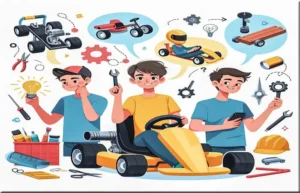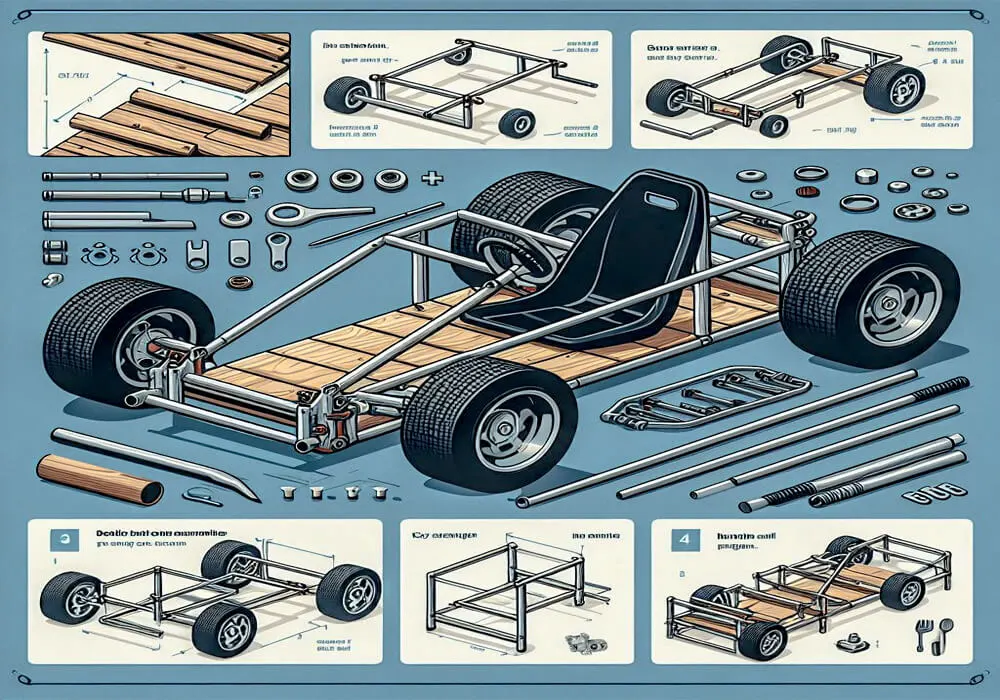How to Make a Go Kart?
How to Make a Go Kart?Go karts are a thrilling and fun way to race around tracks or backyards. Building your own go kart can be an enjoyable DIY project that allows you to customize the kart exactly how you want.
With some mechanical skills and the right parts and tools, you can make a fully-functional go kart from scratch. Constructing a go kart is an achievable weekend project if you have access to basic tools and a garage or workspace.
The main components needed are a sturdy frame, wheels and tires, steering, brakes, an engine and drive train, and a seat. With proper planning and preparation, assembling your own go kart can be a rewarding and relatively straightforward process.
The most important steps are designing the frame, installing the engine and drivetrain components, attaching the steering and brake systems, and adding finishing touches like the seat.
Step by step guide to make go kart

Follow these key steps to build a safe and high-performing homemade go kart from the ground up:
Design and Construct the Frame
The frame connects all the go kart components and supports the driver.
Most DIY frames are made from steel tubing, which provides strength while keeping weight low.
- Decide on the size and shape of the frame based on your planned engine, drivetrain, and whether it will be a one-seater or two-seater go kart. Generally a compact, open frame is best.
- Use 1-1.5 inch diameter steel tubing with a wall thickness of around 0.120 inches. Mild steel tubing is inexpensive and sufficient for most builds.
- Cut and weld the tubing into the desired frame shape. A basic layout is two parallel main rails connected by lateral and diagonal cross bars.
- Add supporting elements like crossbars under the seat for rigidity. Over-engineer the frame for maximum durability.
Mount the Engine
The engine provides the power to propel the go kart. Small gas engines with 5-10 hp are common for DIY go karts.
- Select a suitable engine based on your performance goals and budget. Test its compatibility with the drivetrain.
- Create engine mounts from steel plate welded onto the frame. Position the engine low and centered on the frame.
- Bolt the engine securely onto the mounts. Add a drive sprocket, clutch, or pulley that connects to the drivetrain.
Install the Drivetrain
The drivetrain transfers power from the engine to the wheels. The basic components are sprockets, a chain, live axle, differential, and axles.
- Attach a driven sprocket to the live rear axle, matching the size of the drive sprocket on the engine.
- Use #40 or #41 chain to connect the drive and driven sprockets at the desired gear ratio.
- Mount the live axle to the frame above the rear tires with U-bolts or welded brackets. Add chain tensioners.
- Install a differential if building a rear-wheel drive kart, or direct drive axles for front-wheel drive.
Add Steering
The steering system allows you to smoothly control the direction of the kart. A basic setup uses tie rods connected to a steering wheel.
- Weld two stub axles with tie rod ends to the front of the frame to hold the kingpins and wheels.
- Attach tie rods to the kingpins and attach the tie rod ends. This joins the wheels for synchronized steering.
- Mount a steering wheel to a column attached to the central tie rod. Use U-joints for smooth steering.
- Fine-tune components like tie rod lengths to ensure precise steering with no binding.
Install Brakes
Reliable brakes are critical for controlling speed and stopping. Hydraulic disc brakes offer the best performance for go karts.
- Mount a brake caliper and rotor on each rear wheel hub. This provides the most braking power.
- Run steel brake lines from the calipers to a master cylinder activated by a brake pedal. Add fluid and bleed the system.
- Adjust the caliper positioning and pad clearance to ensure even braking and rotor contact. Bed in the pads.
- Optional: Add a handbrake with a separate caliper on the driveshaft for the rear wheels.
Add Wheels and Tires
Wheels and tires affect handling, grip, ride comfort and speed. Small narrow tires are typical for racetrack go karts.
- Match the tires to how you plan to drive – on roads, hard dirt, loose dirt, grass etc. More tread and soft compounds increase off-road grip.
- Use wheels with a 5 bolt pattern to match standard go kart hub sizes. Aluminum wheels reduce unsprung weight.
- Inflate the tires to around 12-15 psi for on-road use, and 8-10 psi for off-road. Lower pressure provides more traction.
Install Seat, Controls and Finishing Parts
The final steps are to add ergonomic controls, a comfortable seat and aesthetic components.
- Mount a bucket seat with secure side grips low in the frame. Add padding for comfort and a seat belt for safety.
- Bolt on a floor pan and side pods from sheet metal to enclose the frame. Paint or powder coat for protection and great looks.
- Add features like a gas pedal, brake light, ignition switch, glove box and rearview mirrors in optimal positions.
- Customize the kart with number plates or decals for your own unique style.
Frequently Asked Questions
Here is questions and their answers about making go kart:
How much does it cost to build a go kart?
The total cost can range from $200 for a very basic kart using mostly scrap parts, up to $2000 or more for a complex custom kart with premium components. Most home built go karts cost $500-800 in parts.
What tools do I need to build a go kart?
Essential tools are welding equipment, power tools like a drill, grinder and cut-off saw, mechanics tools like wrenches, sockets and ratchets, and safety gear like gloves and masks.
What is the best engine for a go kart?
The Honda GX200 is a very popular engine choice. It provides up to 9 hp, is affordable and easy to maintain. Other good options are 6.5hp Predator engines or used engines like Briggs & Stratton.
How fast can a homemade go kart go?
Typical top speeds are 15-45 mph. Lightweight karts with powerful engines can exceed 50 mph. Speed depends on many factors like gearing, weight, engine power, tire grip and aerodynamics.
How old do you have to be to drive a go kart?
There are no fixed laws, but most tracks require drivers to be at least 5-8 years old for youth karts. Fast adult go karts often require a minimum age of 14-16. Always check track policies.
Conclusion
Building your own DIY go kart is an exciting project that will teach you many skills. The process involves fabricating a rugged frame, installing key components like the engine, drivetrain, steering and brakes, and adding customized finishing touches. With proper preparation and safety precautions, you can construct a thrilling, road-worthy go kart entirely from scratch.
The sense of satisfaction from completing a fully functional vehicle with your own hands is hugely rewarding. Once finished, you’ll be able to race, modify and tinker with your creation for years to come. So why not get started on your go kart build today? With this comprehensive guide, you have all the information needed to build the go kart of your dreams.

